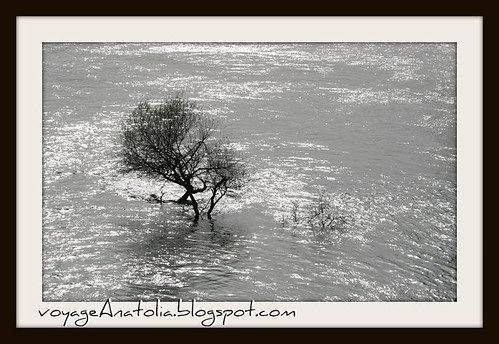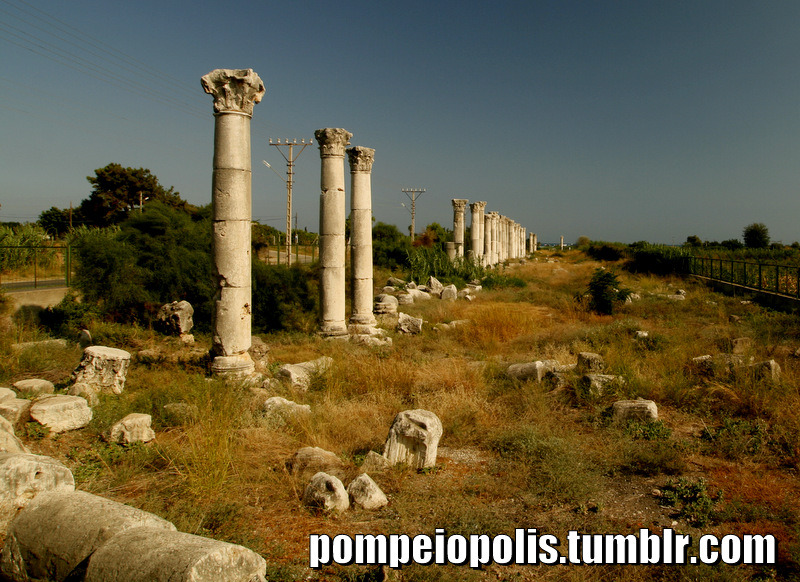
When Alexander the Great passed through with his armies in 333 BC and nearly met his death here after a bath in the Cydnus. Strabo praises the cultural level of Tarsus in this period with its philosophers, poets and linguists. The schools of Tarsus rivaled those of Athens and Alexandria. At this time the library of Tarsus held 200,000 books, including a huge collection of scientific works.

In Stoic cosmology, everything that exists depends on matter, which is passive and inert, and the logos, divine reason, which is active and organizing.
These processes are responsible for the formation, the development, and ultimately, the destruction of the universe in a never-ending cycle.
The human soul is an emanation from the fiery aether which permeates the universe, and sensation is transmission of pneuma-currents from objects, which interact with the substance of the mind, which is the soul's ruling part.
3rd Century BC
- Zeno of Citium (c. 334-262 BC), Founder of the Stoic school in Athens (c. 300 BC).
- Persaeus (306-243 BC), Pupil and friend of Zeno.
- Aratus of Soli (c. 315-c. 245 BC), Pupil of Zeno and poet.
- Athenodorus of Soli (fl. 275 BC), Pupil of Zeno and brother of Aratus.
- Aristo of Chios (c. 310-c. 240 BC), Pupil of Zeno, leaned towards Cynicism.
- Apollophanes of Antioch (fl. 250 BC), Stoic philosopher, friend of Aristo of Chios.
- Dionysius the Renegade (c. 325-c. 250 BC), Pupil of Zeno who became a Cyrenaic.
- Sphaerus (c. 285-c. 210 BC), Pupil of Zeno. Moved to Sparta and Alexandria.
- Herillus of Carthage (fl. 250 BC), Pupil of Zeno, who held that knowledge was the highest good.
- Cleanthes (of Assos) (331-232 BC), Second leader of the Stoic school.
- Eratosthenes (of Cyrene) (fl. 225 BC), Pupil of Aristo. Chief librarian at Alexandria.
- Hermagoras of Amphipolis (fl. c. 225 BC), Stoic philosopher and follower of Persaeus of Citium.
- Chrysippus (of Soli) (c. 280-c. 206 BC), Third leader of the Stoic school. Wrote 705 books.
- Dioscorides (Stoic) (fl. 225 BC), Pupil of Chrysippus. Father of Zeno of Tarsus.
- Aristocreon (fl. 210 BC), Nephew of Chrysippus.
- Zeno of Tarsus (fl. 200 BC), Fourth leader of the Stoic school.
- Eudromus (fl. uncertain), Stoic who wrote a book called "Elements of Ethics".
- Crates of Mallus (fl. 175 BC), Grammarian. Head of the library at Pergamon.
- Diogenes of Babylon (c. 230-c. 150 BC), Fifth leader of the Stoic school.
- Zenodotus (Stoic) (fl. 150 BC), A pupil of Diogenes of Babylon.
- Apollodorus of Seleucia (fl. 150 BC), Pupil of Diogenes of Babylon.
- Basilides (Stoic) (fl. c. 150 BC), Denied the existence of incorporeal entities.
- Antipater of Tarsus (c. 200-129 BC), Sixth leader of the Stoic school.
- Apollodorus of Athens (fl. 150 BC), Historian. Pupil of Diogenes and Antipater of Tarsus.
- Archedemus of Tarsus (fl. 140 BC), Founded a Stoic school at Babylon.
- Panaetius (of Rhodes) (185-109 BC), Seventh leader of the Stoic school.
- Boethus of Sidon (Stoic) (fl. 150 BC), Pupil of Diogenes.
- Polemon of Athens (fl. 150 BC), Geographer, follower of Panaetius.
- Marcus Vigellius (fl. 125 BC), Stoic who lived with Panaetius.
- Heraclides of Tarsus (fl. 125 BC), Pupil of Antipater of Tarsus.
- Dardanus (c. 160-c. 90 BC), Leading figure in the Stoic school in Athens.
- Mnesarchus (c. 160-c. 90 BC), Leading figure in the Stoic school in Athens.
- Publius Rutilius Rufus (158-c. 75 BC), Statesman, orator and historian. Pupil of Panaetius.
- Stilo (c. 154-74 BC), Grammarian and scholar.
- Dionysius of Cyrene (fl. c. 125 BC), Leading figure in the Stoic school in Athens.
- Quintus Lucilius Balbus (fl. c. 125 BC), Stoic philosopher, and a pupil of Panaetius.
- Hecato of Rhodes (fl. 100 BC), Pupil of Panaetius, wrote about ethics.
- Diotimus the Stoic (fl. 100 BC), Stoic who slandered Epicurus.
- Posidonius (of Apamea) (c. 135-51 BC), Stoic philosopher, astronomer, and geographer.
- Crinis (fl. uncertain), Stoic who wrote about logic.
- Proclus of Mallus (fl. uncertain), Stoic philosopher and writer.
- Diodotus the Stoic (c. 130-59 BC), Stoic teacher of Cicero who lived in Cicero's house.
- Geminus of Rhodes (c. 110-c. 40 BC), Astronomer and mathematician.
- Athenodoros Cordylion (c. 130-60 BC), Librarian at Pergamon, lived with Cato.
- Apollonius of Tyre (philosopher) (fl. 50 BC), Stoic philosopher who wrote a biography of Zeno.
- Cato the Younger (95-46 BC), Statesman who opposed Julius Caesar.
- Antipater of Tyre (c. 100-45 BC), Friend of Cato. Wrote about practical ethics.
- Apollonides (fl. 46 BC), Stoic philosopher whom Cato consulted before committing suicide.
- Jason of Nysa (fl. 50 BC), Grandson of Posidonius.
- Athenodoros Cananites (c. 74 BC-7 AD), Pupil of Posidonius. Teacher of Augustus.
- Stertinius (Stoic) (fl. 50 BC), Philosopher satirised by the poet Horace.
- Quintus Sextius (fl. 40 BC), Set up a school teaching Stoicism mixed with Pythagoreanism.
- Arius Didymus (of Alexandria) (fl. 10 BC), Collected excerpts from earlier Stoic writers.
- Theon of Alexandria (fl. 10 AD), Stoic philosopher.
- Attalus (Stoic) (fl. 25 AD), Stoic philosopher frequently visited by Seneca.
- Papirius Fabianus (fl. 30 AD), Teacher of Seneca. Rhetorician and philosopher.
- Julius Canus (fl. 30 AD), Stoic philosopher condemned to death by Caligula.
- Lucius Annaeus Seneca (c. 4 BC-65 AD), Statesman, philosopher, and playwright.
- Thrasea Paetus (c. 10 AD-66 AD), Roman senator and Stoic.
- Lucius Annaeus Cornutus (c. 20-c. 70 AD), Stoic teacher who wrote a Compendium of Greek Theology.
- Chaeremon of Alexandria (fl. 50 AD), Stoic philosopher and grammarian. Librarian at Alexandria.
- Paconius Agrippinus (fl. 60 AD), Stoic philosopher spoken of with praise by Epictetus.
- Heliodorus (Stoic) (fl. 60 AD), Stoic philosopher. Informer in the reign of Nero.
- Publius Egnatius Celer (fl. 60 AD), Stoic philosopher. Informer in the reign of Nero.
- Helvidius Priscus (fl. 65 AD), Stoic philosopher and statesman.
- Arulenus Rusticus (c. 30-93 AD), Statesman. Friend and pupil of Thrasea Paetus.
- Musonius Rufus (c. 25-c. 90 AD), Stoic teacher and writer.
- Euphrates the Stoic (c. 35-118 AD), Philosopher, orator and pupil of Musonius Rufus.
- Dio Chrysostom (c. 40-c. 115 AD), Greek orator, writer, philosopher and historian. 80 orations extant.
- Cleomedes (fl. uncertain), Astronomer who lived later than Posidonius.
- Epictetus (of Hierapolis) (c. 55-c. 135 AD), Philosopher, pupil of Musonius Rufus.
- Hierocles (Stoic) (fl. 150 AD), Philosopher, wrote "Elements of Ethics".
- Flavius Arrianus (c. 90-175 AD), Historian and pupil of Epictetus.
- Basilides of Scythopolis (fl. 150 AD), Teacher of Marcus Aurelius.
- Apollonius of Chalcedon (fl. 150 AD), Stoic teacher of Marcus Aurelius and Lucius Verus.
- Claudius Maximus (fl. 150 AD), Stoic philosopher and friend of Marcus Aurelius.
- Cinna Catulus (fl. 150 AD), Stoic teacher of Marcus Aurelius.
- Sextus of Chaeronea (fl. 160 AD), Stoic philosopher and teacher of Marcus Aurelius.
- Junius Rusticus (c. 100-c. 170 AD), Philosopher and Consul. Adviser of Marcus Aurelius.
- Marcus Aurelius (121-180 AD), Roman Emperor from 161-180 AD.
- Medius (fl. 250 AD), Debated the Stoic theory of eight parts of the soul with Longinus

More on this: pneuma-cosmos.tumblr.com